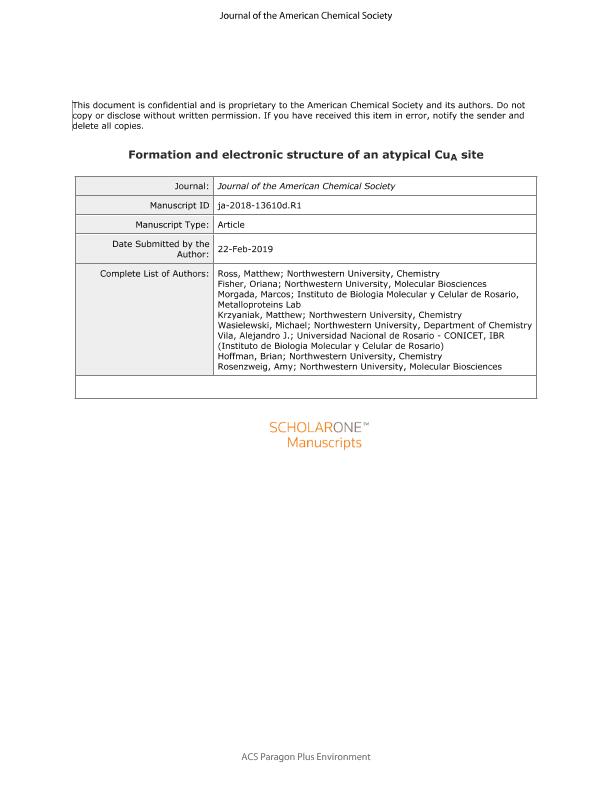Artículo
Formation and electronic structure of an atypical Cu A site
Ross, Matthew O.; Fisher, Oriana S.; Morgada, Marcos Nicolás ; Krzyaniak, Matthew D.; Wasielewski, Michael R.; Vila, Alejandro Jose
; Krzyaniak, Matthew D.; Wasielewski, Michael R.; Vila, Alejandro Jose ; Hoffman, Brian M.; Rosenzweig, Amy C.
; Hoffman, Brian M.; Rosenzweig, Amy C.
 ; Krzyaniak, Matthew D.; Wasielewski, Michael R.; Vila, Alejandro Jose
; Krzyaniak, Matthew D.; Wasielewski, Michael R.; Vila, Alejandro Jose ; Hoffman, Brian M.; Rosenzweig, Amy C.
; Hoffman, Brian M.; Rosenzweig, Amy C.
Fecha de publicación:
02/2019
Editorial:
American Chemical Society
Revista:
Journal of the American Chemical Society
ISSN:
0002-7863
Idioma:
Inglés
Tipo de recurso:
Artículo publicado
Clasificación temática:
Resumen
PmoD, a recently discovered protein from methane-oxidizing bacteria, forms a homodimer with a dicopper CuA center at the dimer interface. Although the optical and electron paramagnetic resonance (EPR) spectroscopic signatures of the PmoD CuA bear similarities to those of canonical CuA sites, there are also some puzzling differences. Here we have characterized the rapid formation (seconds) and slow decay (hours) of this homodimeric CuA site to two mononuclear Cu2+ sites, as well as its electronic and geometric structure, using stopped-flow optical and advanced paramagnetic resonance spectroscopies. PmoD CuA formation occurs rapidly and involves a short-lived intermediate with a max of 360 nm. Unlike other CuA sites, the PmoD CuA is unstable, decaying to two type 2 Cu2+ centers. Surprisingly, NMR data indicate that the PmoD CuA has a pure σu∗ ground state rather than the typical equilibrium between σu∗ and πu of all other CuA proteins. EPR, ENDOR, ESEEM, and HYSCORE data indicate the presence of two histidine and two cysteine ligands coordinating the CuA core in a highly symmetrical fashion. This report significantly expands the diversity and understanding of known CuA sites.
Palabras clave:
CuA
,
PmoD
,
Metanotrophs
,
Ellectronic Structure
Archivos asociados
Licencia
Identificadores
Colecciones
Articulos(IBR)
Articulos de INST.DE BIOLOGIA MOLECULAR Y CELULAR DE ROSARIO
Articulos de INST.DE BIOLOGIA MOLECULAR Y CELULAR DE ROSARIO
Citación
Ross, Matthew O.; Fisher, Oriana S.; Morgada, Marcos Nicolás; Krzyaniak, Matthew D.; Wasielewski, Michael R.; et al.; Formation and electronic structure of an atypical Cu A site; American Chemical Society; Journal of the American Chemical Society; 141; 11; 2-2019; 4678-4686
Compartir
Altmétricas



